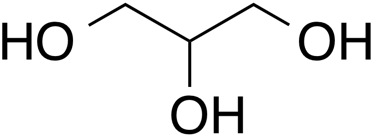

By Gopinathan K. Menon
September 15, 2017

We all know that glycerol (glycerine) is great for our skin in winter. Many skincare products that have superb feel and moisturizing properties contain this time-tested ingredient. This ingredient is also made by your skin through the breakdown of oils by enzymes in the skin. Its production is one of the key functions of the oil glands (sebaceous glands) of skin, helping to keep skin hydrated.1
In clinical and experimental studies, researchers in Europe and the U.S. found that: a) Glycerol modifies the crystalline phase lipid structures of stratum corneum to a liquid crystalline state, which aids in moisture retention by the skin, making it supple;2 b) Due to its humectant properties, glycerol draws moisture from the base of the epidermis towards the outermost layer, stratum corneum, an event that signals increased barrier lipid production, fortifying the skin barrier;3 c) Glycerol facilitates the breakdown of desmosomes (the protein stuctures that hold cells of the stratum corneum together like spot welds), enhancing exfoliation, which improves not only the appearance of the dry skin surface, but also its softness;3 d) Application of glycerol not only hastens the barrier repair after stripping of the stratum corneum (as in minor abrations), but these improvements in barrier and hydration persist up to a week after the end of the study period;4 e) Topically applied glycerol—but not glycerol-like osmolytes (xylitol, erythritol, and propanediol)—can compensate for the genetic deficiency of aquaporins (the water channels of cells), such as that found in aquaporin knock-out rodents.5
The stratum corneum is considered a "smart material", which can generate NMF molecules in response to low humidity conditions.6,7 The lipases present in the stratum corneum also degrade the sebum lipids and generate glycerol. As an integral chemical entity of the stratum corneum, we could regard glycerol as a "smart moisturizer" ingredient, which can repair/restore the skin barrier. Glycerol provides functional moisturization in areas that are moisture depleted and prone to maximum barrier damage, especially in the hands which are often exposed to harsh chemicals in soaps as well as the ravages of winter and the Sun. In short, glycerin works where the skin needs it, by facilitating moisturization as well as barrier repair.
References
1. J.W. Fluhr, M. Mao-Qiang, B.E. Brown, P.W. Wertz, D. Crumrine, J.P. Sundberg, K.R. Feingold, and P.M. Elias, Glycerol regulates stratum corneum hydration in sebaceous gland deficient (asebia) mice, J. Invest. Dermatol., 120, 728-737 (2003).
2. M. Gloor, J. Bettinger, and W. Gehring,
[Modification of stratum corneum quality by glycerin-containing external ointments], Hautarzt., 49, 6-9 (1998).
3. J.W. Fluhr, M. Gloor, L. Lehmann, S. Lazzerini, F. Distante, and E. Berardesca, Glycerol accelerates recovery of barrier function in vivo, Acta Derm. Venereol., 79, 418-421 (1999).
4. A. Rawlings, C. Harding, A. Watkinson, J. Banks, C. Ackerman, and R. Sabin,
The effect of glycerol and humidity on desmosome degradation in stratum corneum, Arch. Dermatol. Res., 287, 457-464 (1995).
5. M. Hara and A.S. Verkman, Glycerol replacement corrects defective skin hydration, elasticity, and barrier function in aquaporin-3-deficient mice,
Proc. Natl. Acad. Sci. USA, 100, 7360-7365 (2003).
6. G.K. Menon, G.W. Cleary, and M.E. Lane,
The structure and function of the stratum corneum, Int. J. Pharm., 435, 3-9 (2012).
7. C. Katagiri, J. Sato, J. Nomura, and M. Denda,
Changes in environmental humidity affect the water-holding property of the stratum corneum and its free amino acid content, and the expression of filaggrin in the epidermis of hairless mice, J. Dermatol. Sci., 31, 29-35 (2003).